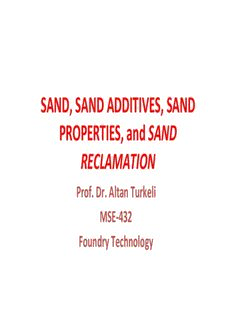
SAND, SAND ADDITIVES and SAND PROPERTİES PDF
Preview SAND, SAND ADDITIVES and SAND PROPERTİES
SAND, SAND ADDITIVES, SAND PROPERTIES, and SAND RECLAMATION Prof. Dr. Altan Turkeli MSE‐432 Foundry Technology SAND ADDITIVES Casting Sand • SAND (SiO2……) • CLAYS (Bentonite…..) • WATER • CELLULOSE (Wood flour, Cob flour…..) • OIL‐CHEMICALS (Soda ash, Polymers….) • REFRACTORIES (Alumina, Silica flour…) • SOLUBLES (Corn flour, Corn sugar…) Flow Chart of a Metal Casting System SAND SAND Casting Sands • Silica Sands • Zircon • Olivine • Chromite • Aluminum Silicates Silica Sands • Most green sand molds consist of silica sands bonded with a bentonite‐water mixture. (The term green means that the mold, which is tempered with water, is not dried or baked.) The composition, size, size distribution, purity, and shape of the sand are important to the success of the mold making operation. • Sands are sometimes referred to as natural or synthetic. • Natural or Synthetic • Natural sands contain enough naturally occurring clays that they can be mixed with water and used for sand molding. • Synthetic sands have been washed to remove clay and other impurities, carefully screened and classified to give a desired size distribution, and then reblended with clays and other materials to produce an optimized sand for the casting being produced. • Because of the demands of modern high‐pressure molding machines and the necessity to exercise close control over every aspect of casting production, most foundries use only synthetic sands.
Description: